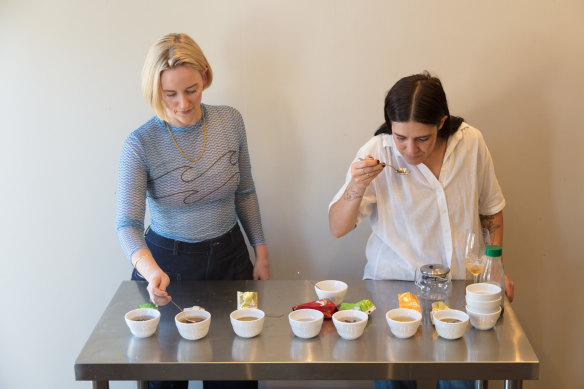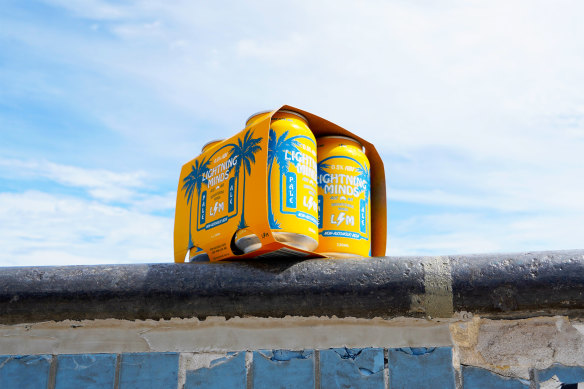Opinion
Sober thoughts: Non-alcoholic drinks trend is shaping Perth venues
Max Veenhuyzen
Restaurant critic and food writer“I was climbing the walls yesterday,” confided a friend to me over the weekend. She was partway through a 100-day reduced alcohol challenge – her version of Dry July – and was missing her Saturday arvo glass of fizz big-time. “I’d cut off my arm for a drink.”
I could empathise. There have been moments during my Dry July run where I’ve been caught off-guard by yearnings. Not just at restaurants. Once while putting away the laundry on a Sunday afternoon. It wasn’t just the situation that shocked me, but also the intensity of my desire. It was, if I’m being honest, a little unsettling.

Imogen Hayes and Christina Trabucco of TINA (This Is Not Alcohol), which makes tea-based pre-packaged drinks.
I’ve been thinking a lot about this over the past fortnight. Chatting with others also doing Dry July or have been off the sauce. These conversations paint a fairly accurate picture – I believe – of Western Australia’s collective relationship with alcohol.
Hospitality staff that abstain during Dry July – or Feb Fast, or Octsober, or any other time – confess to feeling on the outer, especially during post-shift “knock-off drinks”, a beloved team-building exercise for so many hospitality operators. Yet chefs taking a break insist they’re coming up with dish ideas that feel better developed. Colleagues have admitted that (temporary) sobriety has helped them re-evaluate daily life.
Everyone’s relationship with alcohol is personal. People drink – and don’t – for many reasons including health, religion, money or culture. Food writers are considered insufferable and precious at the best of times, so I’m aware of the optics of getting on a soapbox here.
But considering the growing interest in sobriety and reducing alcohol consumption – especially among younger demographics – I feel that there’s a public service element to giving some of these inside thoughts an outside voice. And when you consider how important alcohol sales are to the profitability and even viability of some hospitality businesses, there are professional considerations at play too.
I have no interest in ditching alcohol for good. I appreciate the taste, history, craftsmanship and – yes – the effects too much. But I am interested in improving my relationship with alcohol. No- and low-alcohol drinks are now part of life and hospitality, just like veganism and dairy- and gluten-free diets. Here are some of the thoughts I’ve entertained.
No – or low – non-alcoholic options
While more venues have started taking their offering seriously, I’ve been surprised at how slow other places have been. And not just “normal” places, but high calibre restaurants that bake their own bread, maintain a vigorous fermentation program, celebrate producers and other hallmarks of fine dining. From a hospitality perspective, giving guests just a handful of non-alcoholic drink choices feels mean and from a business perspective, it caps the potential spend from teetotallers, designated drivers and pregnant guests.
Recognising and challenging habits
Often, reaching for a drink comes down to habit and learned behaviours: instantly defaulting to the local pub or wine bar for catching up. (Why not go for a walk?) Or reaching for that rose on a Friday afternoon in the office. (Why not make that first glass or the next a softie?) Or maybe craving a splash of Japanese whisky while folding your clothes as a way to help make the mundane interesting. (Ahem.)

Pre-packaged, single-serve non-alcoholic drinks options are helpful to operators wanting an easy and low-waste option.
While I appreciate the role alcohol plays in helping us connect with others – how many second Tinder dates, I wonder, have spicy margaritas and martinis been responsible for? – the past fortnight has reminded me of how often I drink “just because”. Now that I’m a little closer to 50 than 40 and feel the effects of alcohol more acutely, it makes sense to eliminate some of these unnecessary drinks.Pre-packaged non-alcoholic drinks will continue to rise in popularity…
While I’ve encountered some brilliant non-alcoholic cocktails throughout 2024 – shout out to the drinks Elise Goodwin and her team are slinging at Busselton Pavilion! – I also appreciate that dedicating time and resources to a non-alcoholic drinks program isn’t within every business’s reach. Thankfully, steady growth in the pre-packaged, single-serve non-alcoholic drinks sector is a win-win. Operators have a product – cans of beer, non-alcoholic gin and tonics, spritzes – they can serve quickly and with reduced wastage, whereas opening a bottle of a non-alcoholic wine replacement or kombucha and having to throw most of it away after a few days is a profits killer.)
…as long as customers can see the value
“If you’re charging me the same price for a non-alcoholic cocktail as you are an alcoholic cocktail, there had better be [redacted] in there.” This quip from a pal on her Instagram story made me laugh, but there’s an element of truth. Dealcoholizing beverages costs money and R&D costs need to be recouped, but for all the non-alcoholic products out there on the market – many with price tags comparable to their full-strength counterparts – there are a lot of shaky products representing questionable value. It’s encouraging to see prices for non-alcoholic beers dropping a little at the bottle shop and thankfully the initial explosion of bandwagon jumpers is subsiding with natural selection taking care of the also-rans.
Keep supporting the little guys
Little tetra-packs of sweetened Indonesian tea. House-made lemonades and iced teas. Homestyle soft drinks just like your Japanese grandmother would have made. These are all things you’ll find on the menus and fridges of the small, independent dining rooms and cafes that make this city’s dining scene so exciting. I like learning about the diversity of and history behind alcoholic beverages and recently I’ve been applying a similar curiosity to the liquid assets on offer at the places I check out for work. In addition to offering an insight into different cultures and places, drinking outside my comfort zone helps support those places.
Start the day with a summary of the day’s most important and interesting stories, analysis and insights. Sign up for our Morning Edition newsletter.